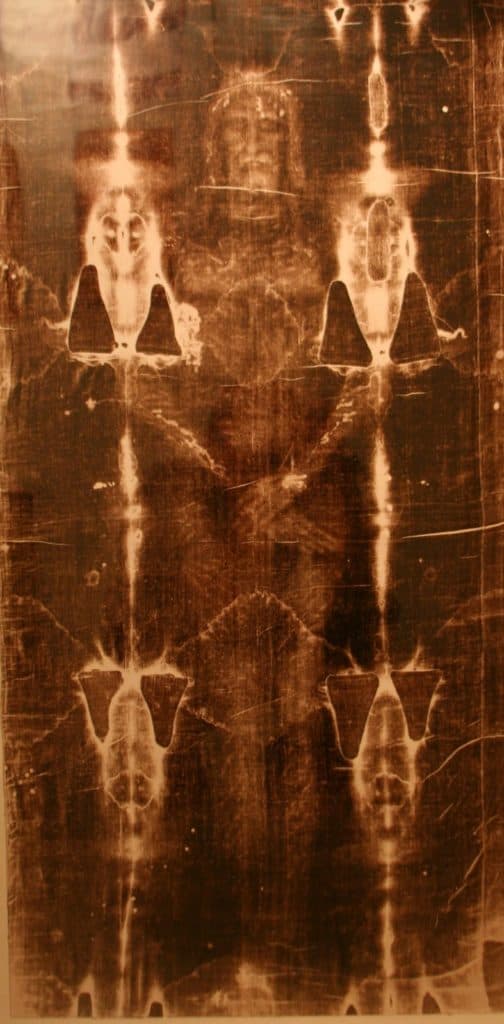BAFTA-winning filmmaker David Rolfe has offered $1 million to the British Museum if it succeeds in duplicating the 'photographic effect' displayed by the Shroud of Turin which has the imprint of a man since they believe it to be an ingenious medieval forgery and not the imprint of Jesus Christ.
- Depth of colour penetration equal to 0.2 micrometre, which corresponds to the thickness of the primary cell wall of the linen fibre. The cellulose of the medulla is colourless.
- Half tone effect, where the shading of the image is due to the areal density of the fibres that each have the same colour, i.e., the same RGB value.
- The fibres are uniformly coloured round their cylindrical surface.
- The front and back images of the body show almost the same colour intensity, i.e., we cannot appreciate which image is more contrasted, front or back.
- The images must be permanent on the linen for a period of at least one year.
- Only known medieval techniques and substances can be used.
'The producers have limited the chosen characteristics to those which can easily be attested and adjudicated by a neutral panel.
'The Museum have six months from Easter Sunday, 2022 (April 17th) to either accept or decline this challenge. Upon their acceptance, the producers will place $1,000,000 in escrow pending the results.
'In accepting the Challenge, the Museum will also grant the Producers the exclusive right to film for both record and dissemination the planning and execution of the process from start to finish.
'The Museum has six months from the first streaming release of the film on 17th April 2022 to accept or refuse the Challenge. No response will be taken as an indication that the Challenge has not been accepted. An appeal for an extension by the Museum will be considered if it shows evidence of application to try and meet the Challenge.' read the statement from Rolfe's website.
Rolfe has released a new documentary challenging sceptics and shedding new light into this most controversial of relics.
Rolfe has returned to the subject of the Turin Shroud which was the focus of his 1978 BAFTA award winning documentary, The Silent Witness. In the years since then, the reputation of this revered Christian relic has been completely undermined by the result of a radiocarbon dating test in 1988, which delivered the verdict that the Shroud was a medieval forgery dating from the period 1260 to 1390 AD. However, there is a catalogue of less well-publicised scientific and historical evidence that contradicts this claim.
'Who Can He Be?' reveals new evidence which casts significant doubt on the validity of the controversial C-14 test carried out in the absence of the five protocols deemed necessary to ensure an accurate result. It also profiles some of the remarkable scientific discoveries that make a compelling case for the authenticity of this revered cloth.

The Shroud continues to stir significant interest worldwide. On Feb. 26, The Museum of the Bible in Washington, D.C., unveiled an interactive, state-of-the-art exhibit on the Shroud. The exhibit, "Mystery and Faith: The Shroud of Turin," will run through July 31.
Longtime Shroud of Turin researcher Joseph Marino, author of two books and more than 60 articles and conference presentations on the Shroud, has just published an article that compiles numerous historical references to Jesus' burial linens from the second century through the first half of the 14th century.
Marino's new 45-page article, "Documented References to the Burial Linens of Jesus Prior to the Turin Shroud's Appearance in France in the Mid-1350s," published on April 8, adds to the growing body of evidence indicating the Shroud of Turin could be the actual burial cloth of the historical Jesus of Nazareth. As a sample of what readers will find in the article, in the sixth century, nearly a thousand years older than the carbon date, an ancient liturgical text translates John 20:5 in the following manner: Peter and John ran to the tomb and saw the recent imprint of the dead and risen man on the linens. There are one or more references for each century from the 2nd through the 14th, clearly demonstrating the existence of the Shroud from right after the time of Jesus through its appearance in France in the mid-14th century.
A former Benedictine monk, Marino has studied the Shroud for 45 years. He was involved in groundbreaking research, which demonstrated that the 1988 C-14 results were invalid. Marino, working alongside his late wife, Sue Benford, found anomalies in the weave pattern in the sample which had been dated. In 2005, in response to Marino and Benford's research, the late Ray Rogers, head of the chemistry section of the 1978 Shroud of Turin Research Project, authored a peer-reviewed paper, "Studies on the Radiocarbon Sample from the Shroud of Turin" in which he concluded that the C-14 sample was not representative of the main cloth, thus invalidating the results. This was further corroborated by the raw data from the three labs, which against all norms they refused to release immediately, were finally obtained through a Freedom of Information request in 2017 made by French researcher Tristan Casabianca. It was published in the peer-reviewed journal Archaeometry, on March 22, 2019. Analysis of the data shows it was clearly manipulated. Had all the data been released in 1989, it would have failed statistical analysis as a reliable test. The latest historical research compiled in a 45-page document strongly supports an age of the cloth much older than the the14th century, as erroneously determined by the carbon dating labs in 1988.


